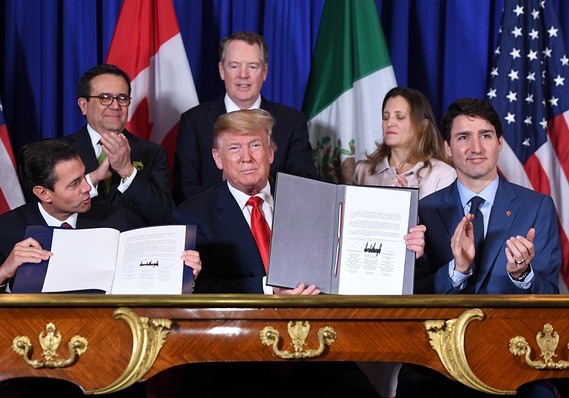Approval should come quick in Mexico and Canada, but the U.S. House has more problems with the deal.
The path to ratify the new trade agreement between the United States, Mexico and Canada is as varied as its acronym in the three countries. In the United States, it is referred to as USMCA or NAFTA 2.0, in Mexico it is T-MEC (Tratado entre México, Estados Unidos y Canadá), and in Canada it is CUSMA.
Ironically, the most arduous process will be in the United States, the country that initiated the new agreement.
Mexico has the shortest route to ratification and probably the easiest. The Mexican Senate has the exclusive power to approve treaties made by the president with foreign countries. Ratification only requires a majority vote in the Senate.
Once the treaty is negotiated by the president and ratified by the Senate, the treaty is considered the supreme law and any contradictory provisions in the constitution, or state laws, must then conform to the newly ratified treaty.
Next week, the Mexican Senate, in its first order of business in its extraordinary session, will likely approve the treaty and Mexican President Andres Manuel Lopez Obrador will quickly decree the law into force.
While the Mexican Constitution sets out an easy ratification process, politically Mexico had to make legislative changes to its labor laws to help address concerns voiced by Democrats in the United States and labor concerns at home.
Once the agreement is introduced, the waiting period is observed and debate on the agreement coincides. Because C-100 includes implementation legislation, it will have to go through the full legislative process, including the House of Commons and Senate.
The House of Commons is schedule to adjourn on June 21 and the Senate on June 28. If C-100 does not pass by the end of June, either session can be extended or called back during the summer. The more likely hard deadline is the middle of September when the writ drops and Canada transitions into election mode for October.
If it is not passed by the middle of September, it will “die on the order paper” and will have to be reintroduced in the next Parliament, which might be a different government.
While the legislative procedure in the U.S. Congress is guided by the trade promotion authority (TPA) laws, the speaker of the House, Democrat Nancy Pelosi of California still has ultimate control on the timing and passage of USMCA.
U.S. Trade Representative Robert Lighthizer submitted a draft statement of administrative action on May 27, which allows the Trump administration to send the agreement to Congress within 30 days. The implementing bill must be passed by both chambers within 90 session days of the bill’s introduction, and the House and Senate can work together to speed up that process.
The concern is whether the speaker will allow the agreement to follow the typical TPA timeline. The administration’s decision to move forward more quickly than Democrats preferred has led to increased tension.
The implementing bill is considered a revenue bill, meaning the House must pass it first. The House has a maximum of 15 session days to vote on the bill once it is on the floor. If the bill is not passed in that time, the bill is no longer safe from amendment and filibuster, and loses the advantage of the expedited TPA process.
Pelosi has made it clear that Democrats “have been on a path to yes,” yet are not entirely satisfied with the agreement as it is now. Moreover, the New Democrat Coalition of moderate House Democrats with their “NAFTA 2.0 Priorities” outline a long list of what the administration will have to do to secure the members’ support for ratification.
These requests include no unilateral tariffs on Mexico, maintaining the removal of Section 232 steel and aluminum tariffs, and strengthening enforcement, labor, and environmental commitments. The coalition also wants to end the threat of tariffs on autos and auto parts, and rejects any effort to lower the current U.S. de minimis threshold (duty-free entrance of goods into the U.S.).
Changes made to address Democrats’ concerns could be solved with side letters, yet Pelosi requested that enforcement provisions be included within the implementing bill instead of as side legislation. At the same time, the New Democrat Coalition is using the current momentum, and the president’s need for their support, to bring attention to infrastructure- and workforce-related legislation, including a push to increase the federal minimum wage.
The USMCA ratification must happen this year in the U.S. or wait until after 2020 with an impending election season, which would move implementation into early 2021. As for now, everyone is waiting on the U.S. to pick up speed.
Until all three counties ratify the new agreement, the original NAFTA continues to govern North American trade. If Congress were to amend their ratification legislation, treaty negotiators among all three countries would then need to determine whether Mexico and Canada would be willing to accept the amended legislation and amend any ratification legislation they might have already passed.
Up to this point, Mexico and Canada have been clear they are not going to renegotiate the underlying agreement.
As the clock continues to tick, the road continues to get steeper for USMCA in the United States.
Ryan Bernstein is a senior vice president in McGuireWoods Consulting’s federal public relations group. A Republican strategist and former chief of staff to Sen. John Hoeven of North Dakota, Ryan assists clients with matters before Congress, regulatory agencies and the executive branch with a particular focus on the agriculture and energy industries.
Mariam Eatedali, a research associate at McGuireWoods Consulting, previously consulted with former representatives and senators to address foreign economic and diplomatic concerns while she was a fellow for the U.S. Association of Former Members of Congress.
McGuireWoods has lobbied on trade issues, including lifting the 232 retaliatory tariffs and for passage of USMCA.








Leave a Reply
You must be logged in to post a comment.